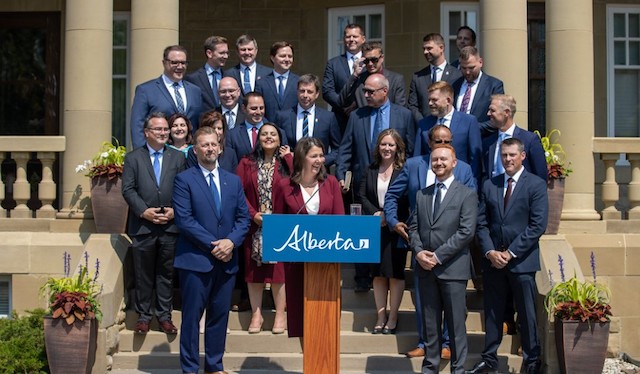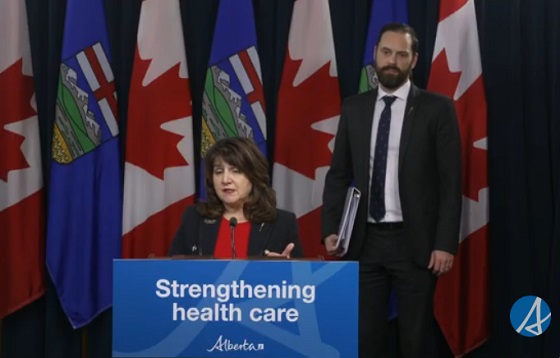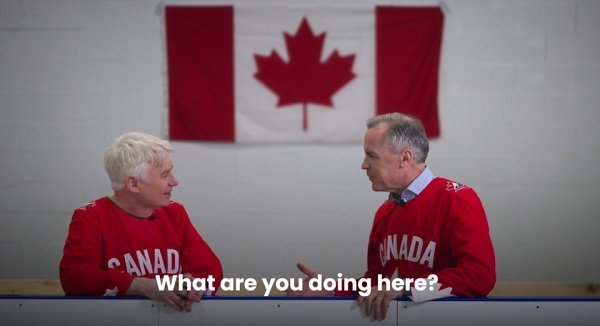Alberta
Ministerial Mandate Letters highlight upcoming showdowns between Alberta and Ottawa

Contributed by Free Alberta Strategy
After every election in Alberta, once the new government is formed and Cabinet has been selected, the Premier provides documents called mandate letters to each of their new Cabinet Ministers. These mandate letters outline the government’s priorities and policy objectives, as well as the Premier’s expectations, for each Minister’s performance in their respective roles. It is also common for these mandate letters to be released publicly, giving us as the public an early look at where the government is likely headed in the coming months and years. Over the last few days, the first of these mandate letters have been released, so we wanted to bring you a few of the highlights.
The constant theme throughout the letters is a very clear message to the federal government that Alberta will be flexing its muscles on the national stage in the coming four years. In particular, the two highest-profile Ministries – namely Finance and Energy – got mandate letters that put the federal government right in their crosshairs.
*****
Drumheller-Stettler MLA Nate Horner is in Cabinet as Finance Minister and has been tasked with looking at the establishment of an Alberta Revenue Agency and an Alberta Pension Plan.
These are both fundamental concepts of the Free Alberta Strategy, and both are strongly opposed by the New Democrats led by Rachel Notley.
The concept of an Alberta Revenue Agency isn’t as scary as most of the opposition is making it out to be.
Quebec already has a Quebec Revenue Agency that collects all provincial tax.
Saskatchewan just passed the Saskatchewan Revenue Agency Act, which gives them the ability to defend Saskatchewan’s economic autonomy, industries and jobs from federal intrusion and constitutional overreach.
Also, Alberta already collects provincial corporate tax through the Tax and Revenue Administration department.
So, in some ways, the Alberta Revenue Agency already exists – we just need to expand its mandate to include other types of taxes other than corporate tax.
This move would also provide greater flexibility for the province when it comes to provincial tax collection policy.
As a bonus, once this is done, we will then be able to join Quebec in lobbying the federal government for the ability of provinces to collect federal taxes.
This is something that Quebec has been pushing for for quite some time, and while they haven’t made any progress in convincing the current federal Liberal Party, several recent Conservative Party leaders have expressed support for the idea.
With regards to an Alberta Pension Plan, there is an actuarial report due to be released sometime soon that has studied this issue.
“It’s something that’s been outlined as a potential opportunity and something that we need to really flesh out and get into the numbers and make sure that Albertans understand,” said Horner.
We’ve pointed out here a few times that Albertans contribute more into the Canada Pension Plan than we take out in benefits.
In essence, Ottawa is using the CPP as just one more way to subsidize the rest of Canada with our money.
We anticipate the report – when it is released – will point out that due to our young demographics and provincial income levels, an Alberta Pension Plan will give us the ability to decrease contributions while maintaining the same benefits to our seniors, keep contribution levels the same while increasing benefits to our seniors, or some combination of the two.
Alberta’s exit from the Canada Pension Plan would also leave a huge hole in the national fund – one that would require premiums to dramatically increase in the rest of the country to make up for the subsidy they’ll no longer be getting from Albertans.
*****
Fort McMurray-Lac La Biche MLA Brian Jean steps into the crucial role of Energy and Minerals, a very fitting role given the riding he represents is the very heartland of the energy industry.
Jean will face off against a federal government that has been violating provincial natural resource jurisdiction ever since its election, and he will be expected to stand up to the politicians in Ottawa who are seeking to systematically decimate our natural resource industry.
Specifically, Jean is tasked with “defending Alberta’s energy interests against federal overreach and developing strategic alliances with other provinces to deal with energy-related issues.”
Recently, Federal Environment Minister Steven Guilbeault has gone so far as to state his belief that oil and gas production is likely to be reduced by 75% by 2050.
And given Justin Trudeau’s plans for a Just Transition / Sustainable Jobs Act, a net-zero electricity grid by 2035, an emissions / production cap on oil and gas at the end of this year, and more, we should believe him when he says he intends to try.
Considering the impact the aggressive climate ambitions of the federal government are anticipated to have on the national economy, prioritizing the defence of the industry on a jurisdictional basis is absolutely essential to ensure the future of Alberta.
*****
Horner, Jean, and the rest of Cabinet are about to become willing participants in the biggest fight of their political lives.
They will be expected to stand up for Alberta against the next wave of federal attacks and wrest control of our future back from Ottawa.
Here at the Free Alberta Strategy, we will be pushing the government to stay resolute in the face of these attacks, and to implement our ideas and proposals.
We’ve seen once before that a government in Alberta can be elected on a strong mandate to stand up to the federal government but back off when left-wing activists and media pressure them to stop.
That’s why we need to keep the pressure on to keep going, and make sure this government follows through.
To help us keep the pressure on, please consider making a donation to the Free Alberta Strategy:
We need your support to continue our research, policy analysis, grassroots organizing, and communications efforts.
Thanks for your support!
Regards,
The Free Alberta Strategy Team
—
DONATE has two key objectives:
- Establishing complete Provincial Legislative Sovereignty within Canada
- Ending Equalization and Net Federal Transfers out of Alberta
The Strategy accomplishes these two objectives through a series of legislative and other policies that must be implemented by Alberta’s Provincial Government
Alberta
Red Deer’s Jason Stephan calls for citizen-led referendum on late-term abortion ban in Alberta

From LifeSiteNews
United Conservative Party MLA Jason Stephan told the legislature that most Albertans agree there should at least be limits on abortion.
Red Deer South UCP MLA Jason Stephan called on the public to rally to bring forth a referendum for a vote to ban late-term abortions.
Stephan spoke in the Alberta legislature on November 19 about late-term abortions, calling for a citizen-led referendum to ban the practice.
“Many Albertans do not want a society that is best at late-term abortions, and many of these Albertans feel that they are ignored on this matter sacred to them,” Stephan said.
“But Alberta has a Citizen Initiative Act, and most Albertans, regardless of faith or background, agree that it is reasonable to have some limits on late-term abortions. That is the case in most democratic jurisdictions.”
Stephan said that Canada is founded on “principles that recognize the supremacy of God.”
“Judeo-Christian principles recognize that men and women are children of God, each having a divine nature and destiny,” he said.
“They affirm the family as ordained of God and that children are a blessing. This is the opposite of Canada’s failure to do nothing about abortion, in particular late-term abortions.”
In Alberta, the Citizen Initiative Act allows the people, should they get 178,000 verified signatures, to call for a referendum, which Stephan said would allow “Albertans to judge for themselves” on the issue of late-term abortion.
“Seeing things as they really are will result in less abortion not by force of law but by the exercise of moral agency informed by truth,” he said
“It will be good for Albertans to have a referendum with honest conversations on late-term abortion, speaking the truth in love as each best understands it, with respect to all. Thank you.”
According to Prolife Alberta, Alberta’s United Conservative Party (UCP) government under Premier Danielle Smith “has the authority to rewrite AHS policy to require that infants born alive after a failed abortion receive the same degree of care as any other newborn child.”
The group is urging Albertans to sign up to support its “Left to Die” campaign and contact their local Members of the Legislative Assembly (MLAs) to “support” a “policy revision” of AHS guidelines, saying it “should be common-sense and bipartisan.”
Prolife Alberta has exposed the fact that late-term abortions happen in the province.
The ruling UCP party’s grassroots members will be debating restricting abortion funding at its upcoming AGM to be held November 28-30.
As reported by LifeSiteNews, People’s Party of Canada (PPC) leader Maxime Bernier has called late-term abortions “disgusting.”
Bernier recently called for an end to “infanticide” after another RightNow video exposed late-term abortions in Canada.
Smith has done well on some points but has been relatively soft on social issues of importance to conservatives such as abortion and has publicly expressed pro-LGBT views, telling Jordan Peterson earlier this year that conservatives must embrace homosexual “couples” as “nuclear families.”
Late-term abortions often result in live births, as the baby is not completely killed during the abortion procedure. As reported by LifeSiteNews recently, 150 babies were born after botched abortions in 2023-2024 in Canada, but it’s not known how many survived.
Similarly, reports from 2018 indicated that 766 babies were born alive after late-term abortions in Canada between 2013 and 2018 and presumably left to die.
There were 368,928 babies born in Canada from 2024 to 2025, a number that would be much greater if not for abortion. For context, in 2022, 97,211 Canadian babies were killed by abortion.
Alberta
Alberta introducing dual practice health care model to increase options and shorten wait times while promising protection for publicly funded services

Enhancing access through dual practice
If passed, Bill 11, the Health Statutes Amendment Act, 2025 (No. 2), would modernize physician participation rules to give doctors flexibility to work in both the public system and private settings. Dual practice would allow physicians to continue providing insured services through the provincial health insurance plan while also delivering private services.
Alberta’s government has looked to proven models in other jurisdictions to guide the development of a model that strengthens access while safeguarding the public system. Dual practice exists in New Brunswick and Quebec and is widely used in countries with top-performing health systems, including Denmark, the Netherlands, United Kingdom, France, Germany, Spain and Australia.
“For years, governments across Canada have tried to fix long wait times by spending more money, yet the problem keeps getting worse. Alberta will not accept the status quo. Dual practice gives us a practical, proven tool that lets surgeons do more without asking taxpayers to pay more. It means shorter waits, better outcomes and a stronger health system for everyone.”
If passed, this dual practice model would be closely monitored to protect Alberta’s public health care system. The government, for example, would ensure that dual practice physicians maintain separate records for the services they provide, so no public funding subsidizes private services.
Bill 11 would include provisions to restrict participation, which could include:
- Mandating that surgeons in dual practice must perform a dedicated number or ratio of surgeries in the public system to be eligible to perform surgeries privately.
- Restricting specialties to public practice if shortages would compromise public care.
- Potentially restricting private practice to evenings, weekends or to underutilized rural sites, as required.
Alberta’s government remains committed to its public health guarantee: No Albertan will ever have to pay out of pocket to see their family doctor or to get the medical treatment they need. These proposed changes comply with the Canada Health Act.
Alberta’s government is also committed to getting Alberta’s dual practice model right and to taking a thoughtful approach to ensure the best path forward. At this time, family medicine providers will not be eligible to be flexible participants within this new model. The priority is to focus on making sure all Albertans have access to a primary care provider. Additionally, surgeries for life-threatening conditions such as cancer and emergency procedures will remain entirely publicly funded with no private option available.
“Albertans are waiting too long for the health care they need, so we are taking bold and decisive action to shorten wait times, increase access and give Albertans more choices over their own health care. At the same time, we will continue building a strong public health system where no one is denied access to the services they need because of an inability to pay.”
If passed, Bill 11 would create new options for doctors and patients. It would expand Alberta’s health system to provide more care by allowing doctors to treat more patients. Each time a patient chooses to pay for care in a private clinic or a clinic operating on evenings and weekends, for example, resources would be freed up so another patient could receive publicly funded care. This proposed new model would also support physician attraction and retention.
“As dual practice enhances flexibility for Albertans, physicians and medical professionals, safeguards will be established and utilized to protect and grow hospital and public health system capacity.”
“Albertans deserve choice and timely access to safe care, whether in a private or public setting. With the creation of the dual practice model, we can extend treatment options to patients while helping hospitals focus their resources on the highest-acuity patients.”
“I believe all options to improve access to health care for Albertans should be on the table. Therefore, the government’s dual practice legislation is a welcome option. Appropriate guardrails must be in place to ensure the spirit of the Canada Health Act is maintained.”
Quick facts
- Physicians would continue to bill the provincial plan for public services and may offer private services separately.
- Physicians may still choose to work entirely in public or entirely in private settings.
Proposed legislation would modernize physician rules, drug coverage, food safety and health cards while improving oversight and administration in Alberta’s health system.
If passed, Bill 11, the Health Statutes Amendment Act, 2025 (No. 2), would amend several pieces of legislation to reflect Alberta’s evolving health needs, strengthen the ability of health care professionals to deliver care and improve accountability and efficiency across the system.
“This legislation represents a new era for health care in Alberta. By putting patients first and supporting providers, we are improving transparency, flexibility and access. With modernized physician rules, stronger drug coverage, enhanced food safety and better health information sharing, Albertans will have world-class care.”
Protecting drug coverage for Albertans
If passed, amendments would improve coordination between public and private drug plans, ensuring taxpayer-funded programs are used efficiently and remain available for those who need them most.
Private plans would become the first payer for individuals who have them, with public programs acting as a safety net. The legislation would also protect older Albertans by ensuring employers cannot reduce or terminate health benefits for employees aged 65 and older who remain actively employed.
“People shouldn’t be punished for getting older – it’s that straightforward. With this legislation, we’re protecting Albertans by ensuring employers can no longer kick folks off their health benefits when they need them most.”
Ensuring consistent billing and remuneration practices
Alberta’s government is also proposing amendments to the Alberta Health Care Insurance Act to ensure health care providers and clinics are not engaging in improper billing practices and making inappropriate claims. The proposed amendments would strengthen accountability and transparency while generating cost savings by introducing penalties for systemic non-compliance.
Strengthening food safety in Alberta
If passed, amendments to the Public Health Act and related regulations would strengthen food safety across all establishments by improving training for staff, increasing transparency of inspection results and giving inspectors new tools for oversight and investigation.
The changes would also update the Food Regulation, Food Retail and Food Services Code, Institutions Regulation and create a new Public Health Investigator Regulation, ensuring consistent standards, better reporting and increased public confidence in Alberta’s food safety system.
“Enhancing food safety in Alberta is an important step to making sure Albertans have the safeguards and protections in place to keep them healthy and well. If passed, these amendments to the Public Health Act will ensure food establishments are following best practices and that enforcement measures are in place to support proper food safety.”
Improving health cards and information sharing
If passed, the legislation would create a new process for health card renewal, prevent card misuse and allow cards to be seized or suspended if tampered with. The changes would also permit information sharing with the ministries of Technology and Innovation and Service Alberta and Red Tape Reduction to support continued efforts to modernize health cards.
Amendments to the Health Information Act would support a more integrated health care system and seamless patient experience to help improve care for Albertans who are accessing the system.
It would also add new authority to enable health foundations to better connect with patients to support innovation and advancement of care in their community in an appropriate manner, in accordance with the requirements set out in regulations.
“Albertans generously support enhancements to health care delivery, innovation and research in their communities each year. We look forward to working with our health partners across the continuum to better communicate with grateful patients. With these changes, we will join other Canadian jurisdictions in connecting patients with health foundations in their community while ensuring the strongest protection of Albertans’ private health data.”
Advancing a new era of health care
If passed, proposed amendments to the Alberta Health Care Insurance Act and the Provincial Health Agencies Act would support operational changes to implement previously announced objectives like transitioning Alberta Health Services to a hospital-based acute care service provider.
The proposed amendments would also result in the repealing of the Hospitals Act, as all hospital governance and operational provisions would be moved into the Provincial Health Agencies Act.
New dual practice model to increase access and choice
The Health Statutes Amendment Act, 2025 (No. 2) includes proposed amendments to the Alberta Health Care Insurance Act that would modernize how physicians participate in Alberta’s publicly funded health insurance plan. The changes would introduce a new dual practice model, giving physicians greater flexibility to provide care in both public and private settings while maintaining safeguards to ensure Albertans continue to have access to publicly funded health services.
-

 Carbon Tax2 days ago
Carbon Tax2 days agoCarney fails to undo Trudeau’s devastating energy policies
-

 Business2 days ago
Business2 days agoBudget 2025: Ottawa Fakes a Pivot and Still Spends Like Trudeau
-

 Health2 days ago
Health2 days agoTens of thousands are dying on waiting lists following decades of media reluctance to debate healthcare
-

 Opinion2 days ago
Opinion2 days agoLandmark 2025 Study Says Near-Death Experiences Can’t Be Explained Away
-

 International14 hours ago
International14 hours ago“The Largest Funder of Al-Shabaab Is the Minnesota Taxpayer”
-

 Focal Points2 days ago
Focal Points2 days agoSTUDY: TikTok, Instagram, and YouTube Shorts Induce Measurable “Brain Rot”
-

 Bruce Dowbiggin20 hours ago
Bruce Dowbiggin20 hours agoElbows Down For The Not-So-Magnificent Seven: Canada’s Wilting NHL Septet
-

 Censorship Industrial Complex17 hours ago
Censorship Industrial Complex17 hours agoUK Government “Resist” Program Monitors Citizens’ Online Posts








